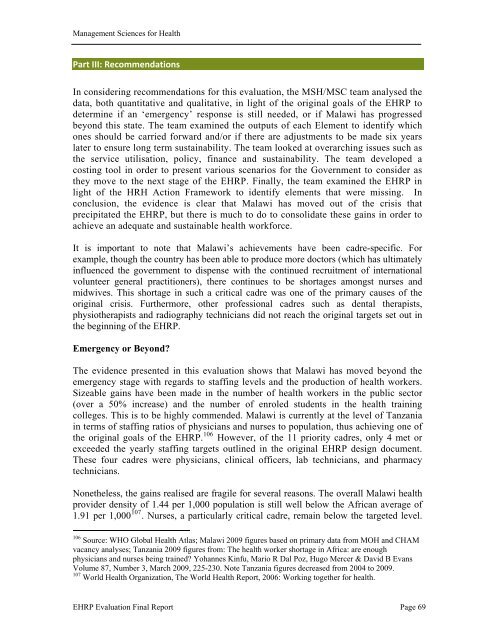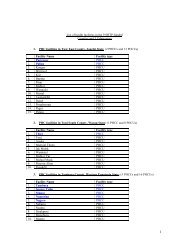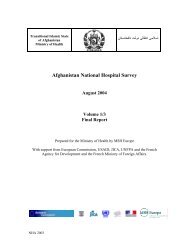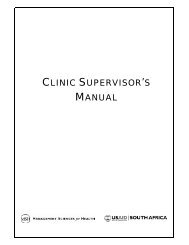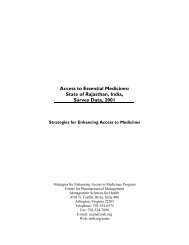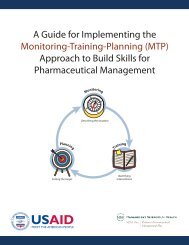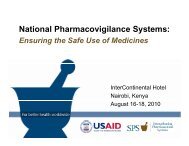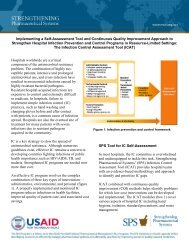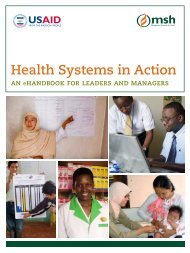Evaluation of Malawi's Emergency Human Resources Programme
Evaluation of Malawi's Emergency Human Resources Programme
Evaluation of Malawi's Emergency Human Resources Programme
Create successful ePaper yourself
Turn your PDF publications into a flip-book with our unique Google optimized e-Paper software.
Management Sciences for Health<br />
Part III: Recommendations<br />
In considering recommendations for this evaluation, the MSH/MSC team analysed the<br />
data, both quantitative and qualitative, in light <strong>of</strong> the original goals <strong>of</strong> the EHRP to<br />
determine if an ‘emergency’ response is still needed, or if Malawi has progressed<br />
beyond this state. The team examined the outputs <strong>of</strong> each Element to identify which<br />
ones should be carried forward and/or if there are adjustments to be made six years<br />
later to ensure long term sustainability. The team looked at overarching issues such as<br />
the service utilisation, policy, finance and sustainability. The team developed a<br />
costing tool in order to present various scenarios for the Government to consider as<br />
they move to the next stage <strong>of</strong> the EHRP. Finally, the team examined the EHRP in<br />
light <strong>of</strong> the HRH Action Framework to identify elements that were missing. In<br />
conclusion, the evidence is clear that Malawi has moved out <strong>of</strong> the crisis that<br />
precipitated the EHRP, but there is much to do to consolidate these gains in order to<br />
achieve an adequate and sustainable health workforce.<br />
It is important to note that Malawi’s achievements have been cadre-specific. For<br />
example, though the country has been able to produce more doctors (which has ultimately<br />
influenced the government to dispense with the continued recruitment <strong>of</strong> international<br />
volunteer general practitioners), there continues to be shortages amongst nurses and<br />
midwives. This shortage in such a critical cadre was one <strong>of</strong> the primary causes <strong>of</strong> the<br />
original crisis. Furthermore, other pr<strong>of</strong>essional cadres such as dental therapists,<br />
physiotherapists and radiography technicians did not reach the original targets set out in<br />
the beginning <strong>of</strong> the EHRP.<br />
<strong>Emergency</strong> or Beyond?<br />
The evidence presented in this evaluation shows that Malawi has moved beyond the<br />
emergency stage with regards to staffing levels and the production <strong>of</strong> health workers.<br />
Sizeable gains have been made in the number <strong>of</strong> health workers in the public sector<br />
(over a 50% increase) and the number <strong>of</strong> enroled students in the health training<br />
colleges. This is to be highly commended. Malawi is currently at the level <strong>of</strong> Tanzania<br />
in terms <strong>of</strong> staffing ratios <strong>of</strong> physicians and nurses to population, thus achieving one <strong>of</strong><br />
the original goals <strong>of</strong> the EHRP. 106 However, <strong>of</strong> the 11 priority cadres, only 4 met or<br />
exceeded the yearly staffing targets outlined in the original EHRP design document.<br />
These four cadres were physicians, clinical <strong>of</strong>ficers, lab technicians, and pharmacy<br />
technicians.<br />
Nonetheless, the gains realised are fragile for several reasons. The overall Malawi health<br />
provider density <strong>of</strong> 1.44 per 1,000 population is still well below the African average <strong>of</strong><br />
1.91 per 1,000 107 . Nurses, a particularly critical cadre, remain below the targeted level.<br />
106 Source: WHO Global Health Atlas; Malawi 2009 figures based on primary data from MOH and CHAM<br />
vacancy analyses; Tanzania 2009 figures from: The health worker shortage in Africa: are enough<br />
physicians and nurses being trained? Yohannes Kinfu, Mario R Dal Poz, Hugo Mercer & David B Evans<br />
Volume 87, Number 3, March 2009, 225-230. Note Tanzania figures decreased from 2004 to 2009.<br />
107 World Health Organization, The World Health Report, 2006: Working together for health.<br />
EHRP <strong>Evaluation</strong> Final Report Page 69


